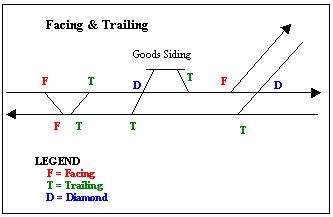Facing and trailing

Facing and trailing are terms used to describe railway turnouts (or 'points' in the UK) in respect to whether they are divergent or convergent. When a train traverses a turnout in a facing direction, it may diverge onto either of the two routes. When travelled in a trailing direction, the two routes converge onto each other.
History
In the early history of railways in Britain, when signalling and interlockings were primitive, and staff were inexperienced, facing turnouts were a hazard, because they could switch a train travelling at high speed into a slow speed divergence or dead end. Facing turnouts were therefore banned, except when absolutely necessary. Facing turnouts cannot be avoided on single lines and their crossing loops.
With the widespread availability of electrically interlocked signalling in modern times, the rule against facing turnouts has been relaxed.
Diamond crossings
Fixed diamond crossings (with no moving parts) count as trailing points in both directions, although in very exceptional circumstances such as propelling a train in reverse over fine angle diamond crossings they can derail wagons as they bunch up.
So-called switch(ed) diamonds, which contain two stub turnouts in disguise, count as facing turnouts in both directions and are also known as moveable angles (UK).
Moveable crossings
Fixed V-crossings are trailable in both directions. Moveable crossings are effectively facing in both directions and must be correctly aligned.
Stub switches
Stub switches are effectively facing in both directions and must be correctly aligned.
Double junctions
Double junctions are now configurable in a number of different ways, whereby the number of facing and trailing turnouts vary.
Goods siding
The goods siding on a double line (in the above diagram) uses two trailing points and a diamond. It can be shunted by trains in either direction.
This was widely done in New South Wales, though later on the diamond crossing was replaced with a pair of ladder crossovers; such as:
- Bredalabane (S)
- Jerrawa (S)
- Woy Woy (N)
- Newbridge (W)